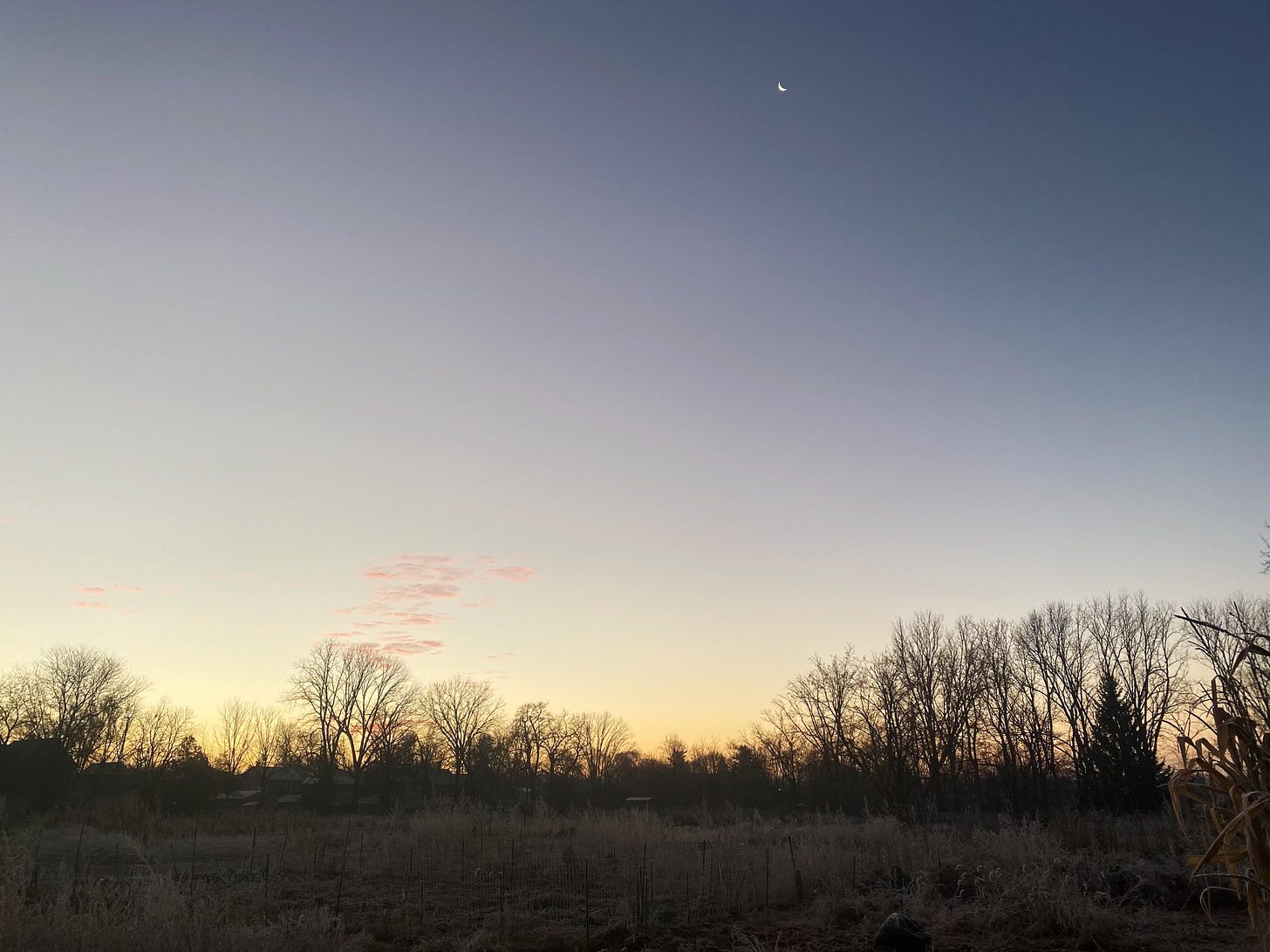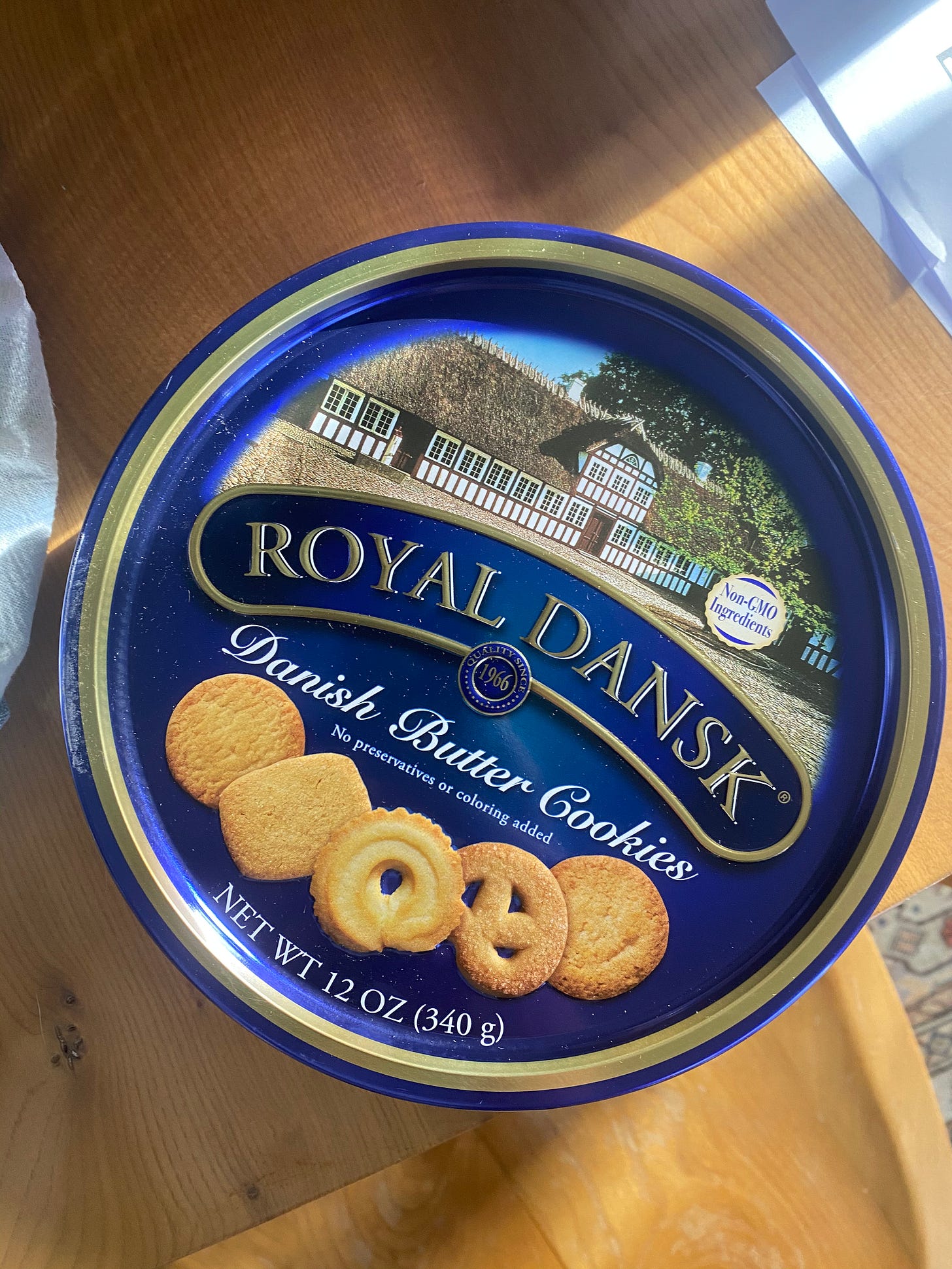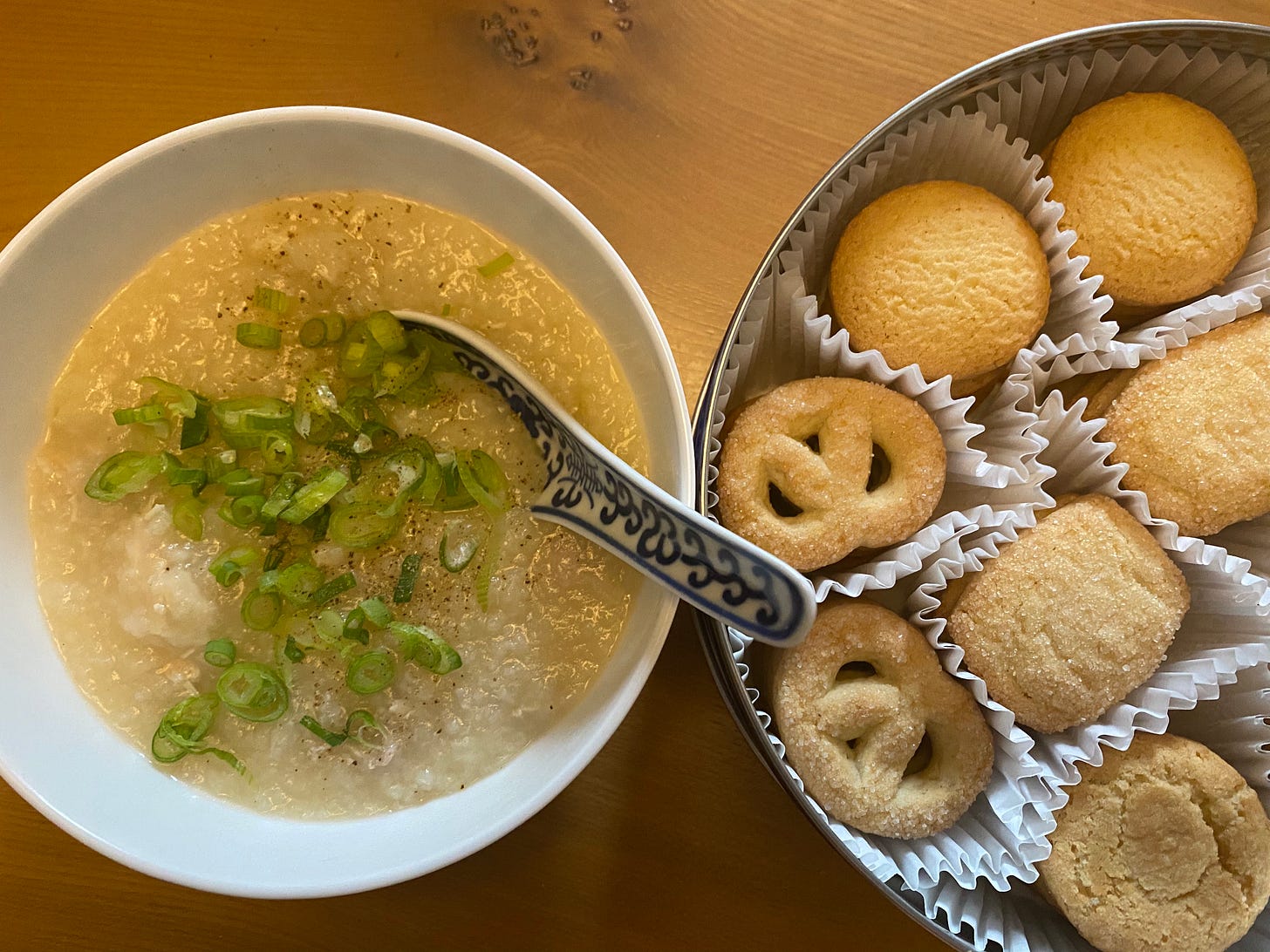Waiting
Some fragmented thoughts on concepts of time, this endless Advent, Danish butter cookies, congee, and a puzzling Christmas music video
The 197th Day after Coronatide*
Grand Rapids, Michigan
Hello, dear reader!
What is time anymore?
The other day, I was discussing this extraordinary year with a friend, and we briefly talked about how we mark time. For instance, I’ve always been a New Year’s curmudgeon. It’s just an arbitrary change of numbers. The clock turning from 11:59 p.m. on December 31st to 12:00 a.m. on January 1st means little except an excuse to drink champagne. Yet my 2019 was so marked with grief and loss that I welcomed 2020 with uncharacteristic enthusiasm. Silly me!
My people tend to see time as cyclical. This isn’t to say that we’re stuck on some temporal hamster wheel or in a never-ending version of “Groundhog Day” (an annoying movie). But we also traditionally don’t subscribe to Western notions of time as forward motion. Instead, our framing of time helps us understand the world around us—the months are marked by the movements of the moon. And it tries to make sense of what’s needed for balance and equilibrium—both night and day, darkness and light, cold and heat, yin and yang. Harmony is the core organizing principle.

I suppose the church year is similar, except that the central orientation is toward faithfulness. You can see some of the church calendar’s ancient, Eastern heritage, too, in the lunar-led shifts of Easter Sunday. Advent, Christmas, Ordinary Time, Lent, Easter, more Ordinary Time: These rhythms remind us of different aspects of life and faith, and year after year, they return us regularly to anticipation and celebration, longing and fulfillment, penitence and hope.
Both the Chinese and church models of time—and they’re just models, constructs that help us to perceive changing seasons as well as our own brief flickering on this earth—compel us to think beyond our limited selves. They tell us that, in many ways, the past is still present. And what’s largely absent from both is some strict notion of linear progress.
None of this means that the Chinese and ecclesiastical cultures have forsworn the entire idea of progress or the possibility of growth. Things change, of course, and as they do, we hope that society and humanity change for the better, not the worse. But more cyclical ways of marking time reshape how we process change. They disabuse us of the sentiment that new is necessarily better or that the future is automatically superior to the past. Summer is not somehow better than winter and, as we all now know, 2020 was never destined to be inherently superior to 2019.
2020 has done its own remarkable thing in complicating our understanding of time, particularly by jarring many of us from our usual comfort—I’d even go so far as to say “complacency.” I think it has also invited us to be more perceptive of the world around us, more aware of what we do and why we do it, more cognizant of what’s beautiful and what’s ugly, what’s healthy and what’s unjust.
Sometime in late winter or early spring, not long after the COVID-19 lockdown began, I remember someone saying that this was the Lentiest Lent they could remember. Those of us who observe this version of the Christian calendar typically see Lent as a penitential season, but this year was different—more sober, more pungent. For many of us, death felt present in a way it didn’t before.
Then we marked Easter, but it wasn’t the celebration it usually is.
Then we had Pentecost, but it didn’t feel as festive as it often is.
As we worked our way through Ordinary Time, the term “Ordinary Time” seemed laughable, because nothing about our lives, ecclesiastical or otherwise, was ordinary.
It even seemed as if we skipped straight from a prolonged Lent into a precocious Advent—a season of waiting and waiting and waiting that has been more than just liturgical and more than just symbolic.
Waiting for an end to the pandemic.
Waiting for a resolution to this fractious election season.
Waiting to be with loved ones again.
Waiting to travel and explore the world again.
Waiting to sing together in church again.
Waiting to linger over a long meal in a restaurant again.
Waiting for joy.
Waiting for salvation.
To wait can be tiring yet hopeful, frustrating yet inspiring. Even as we sit in the tension between what has been and what might be, we try to hold onto our sense of possibility. Sometimes we might have to battle apathy, remembering that waiting well requires discipline and purpose.
We wait because we hope for healing.
We wait because we are convinced that justice will come.
We wait because we have known the deep satisfaction of togetherness.
We wait because we have experienced the exhilaration of adventure before.
We wait because we can still hear the gorgeous echoes of the songs we have sung.
We wait because we can recall the deliciousness of feasts past and anticipate the flavors of feasts to come.
We wait because, even amidst sorrow, we know there’s more.
We wait because we acknowledge that some things are beyond us, that we need help, that we can’t get through this alone.
If you’re hoping for some tidy platitude to wrap this essay up, I’m sorry, but I don’t have one. I’m still trying to make sense of all this longing, all this waiting. I do wonder, though, whether it’s easy to go through the motions of Advent waiting when nothing more is at stake than whether someone got you the Christmas presents you wanted. It’s easy to wander through Ordinary Time when “ordinary” equals “comfortable.” It’s easy to play at Lent when penitence is more ritualistic than a real confrontation between life and death.
Yet maybe none of this was ever meant to be materially rewarding or comfortable or easy. And perhaps 2020 has done some worthy work on us after all, summoning us to think harder about the reality—and fragility—of being human in this beautiful but broken world.
What I’m Cooking (and Eating): I was texting last week with a couple of Canadian friends when one shared a picture of a round, blue metal tin: Royal Dansk butter cookies! We quickly realized that these were a fixture of all our childhoods, except I grew up on Kjeldsens, the more popular brand among Hong Kong people. (The same company now makes both Royal Dansk and Kjeldsens.)
If you’d wandered into my grandparents’ cluttered apartment, you might have thought that our diet was all butter cookies all the time: Those tins were in every room. People often gave the cookies to my grandparents as gifts—Chinese preachers got a lot of those tins—and I don’t think my grandmother ever threw an empty one away. They became receptacles for all manner of small household objects: needles and thread, buttons and coins, odds and ends that had no place else to go all found a home in one of those blue Danish cookie tins. After she died, we even found one stashed at the bottom of a giant box of yarn, full of twenty-dollar bills.
Drowning in my nostalgia, I went online the other day and ordered a tin. After it arrived, I made the meal that, in my family, traditionally allowed the kids to get one of (or six of) those cookies: congee. It’s basically rice porridge, and there’s no one right way to make it. Some eaters like it thin and gruel-like while others prefer it thick, some like the grains of rice to maintain their shape while others want it fully broken down, and some like it plain, perhaps just with salt and white pepper, while others fill it with all kinds of other ingredients.
I didn’t like congee when I was a kid. It tasted like disappointment. My mom usually made it for breakfast the morning after Thanksgiving, Christmas, or any other big family gathering, so it felt like a (non-alcoholic) hangover after a great feast. After dinner, she’d take the remnants of the turkey—or, more often, the roast duck—and toss them into a CrockPot to cook overnight with rice, water, and perhaps a knob of ginger. The next morning, the rice porridge would be ready. It was always best if she made it with duck, which infused the congee with fragrant five-spice and soy. Still, it was never as yummy to me as whatever we’d had for dinner the night before.
A few years ago, my mom and I took a rare mother-son trip, because I got a reporting assignment that called for a food-loving reporting assistant. In Hong Kong, we popped into one of those nondescript eateries where the tile floors and walls seem constantly sweaty, every customer rinses their bowls and chopsticks in hot tea because who can trust the hygiene standards, and there are just plastic stools, no chairs. We ordered congee with frogs’ legs. As I sat with my mom, both of us liberating little bits of meat from bone and slurping porridge—thin in texture, rich in flavor—something changed. Congee was redeemed.
On Monday morning, I simmered half a scoop of rice in a lot of broth for about an hour and a half, seasoning it only with salt and pepper. I had no frogs’ legs. In Chinese, frog meat is called 田雞—literally “field chicken,” and please don’t ask me to explain that. But I did have a boneless, skinless chicken thigh in the fridge that had already been poached, so I chopped that up and threw it in just long enough to warm the pieces through. Then I ladled some congee into a bowl, scattered some finely sliced scallions on top, and opened my tin of cookies.
The cookies don’t go in the congee—that would be weird. They’re an accompaniment. The flavors—the savory of the congee, the sweet of the cookies, especially the pretzel-shaped ones with topped with sugar, which are somehow the best—don’t pair particularly well. But the cookies bring crunch that the congee lacks, and the memories of porridges past do the rest of the work.
What I’m Reading: The writer Anand Giridharadas had a thought-provoking conversation with Sherrilyn Ifill, the president of the NAACP Legal Defense and Educational Fund. Sherrilyn, who was a speaker at Evolving Faith 2020, is brilliant. I especially appreciated what she said about President-elect Biden’s cabinet-in-formation: “I don't particularly enjoy the line, ‘I’m going to have a cabinet that looks like America.’ I call that cosmetic diversity. I'm not interested in cosmetic diversity. I'm interested in substantive diversity.” She talks movingly about accountability, justice, and what we really want as a country. It’s worth a read.
You know I’m always a sucker for finding meaning in the lives of plants, and Karen Attiah, a Washington Post editor, had a lovely piece reflecting on the fig tree in her family’s backyard. (If you don’t subscribe to the Post—and I do encourage you to support journalists by subscribing to publications and not just reading everything for free!—you can open the link in an “Incognito” window.)
Finally, there’s a rich, deeply reported piece on Mormonism in the Atlantic by McKay Coppins, one of the most thoughtful reporters in Washington. He usually writes about politics. But here, he delves beautifully into the strange story of Latter-Day Saints as well as his own personal faith. Full disclosure: I went to an evangelical Christian school where one of the most popular Bible classes was called “Cults”; we did an LDS unit. So I suppose my high-school self falls into the category Coppins discusses of Americans who regard his beliefs with skepticism (at best) and perhaps even derision.
What I’m Listening to: Mariah Carey’s “All I Want for Christmas” remains the best, most earwormy modern Christmas song—don’t @ me. But given 2020 and, okay, the Advent season’s underlying purpose as well as Christmas’s true spirit, “Hallelujah,” the new song from Carrie Underwood and John Legend, might make a decent claim for being more spiritually on-point. I have so many questions about this music video: Why is John Legend wearing gloves when Carrie Underwood is wearing that dress? Are the candle-holding civilian hordes marching on the mansion for class warfare and revolution? Wait, are they ghosts? How is the piano still in tune in that half-abandoned-yet-glam, Miss Havisham-worthy mansion? Why are there church pews in that living room? How does any of this make sense? But I still like the song.
All right, I’ve droned on long enough! As always, I am so glad we can stumble through all this together. Words have come more slowly in recent weeks—yet I ended up with so many words! I will try to write again soon.
Yours,
Jeff
*It feels like foolishness that I’m still counting my days from June 1st, when my governor, Gretchen Whitmer, lifted Michigan’s stay-at-home order. Though I am hopeful because of the arrival of COVID-19 vaccines, I am also grief-stricken that more than 300,000 people have died from this disease in the U.S. alone. Please continue to wear your masks, stay home, and stay safe.



